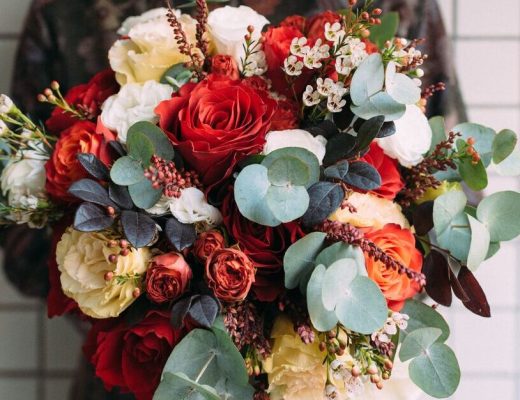Native to South Africa, clivia plants are popular houseplants that can survive in almost any environment. They are evergreen perennials, thrive in shaded areas, and come in many different colours.
You can easily grow clivias both indoors and outdoors, preferably in containers, depending on the climate.
The interesting thing about Clivia plants is that over the years, they’ve become surprisingly popular with collectors. As a result, clivias can be quite expensive, some plants selling for $50 or more.
Read on to find out why people love Clivia plants so much and how to properly grow and care for them.
Clivia Plants 101
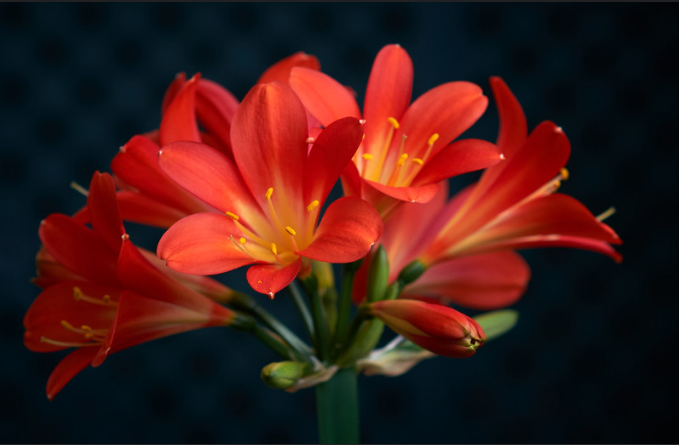
Clivia, also known as Bush Lily, Natal Lily, or Kaffir Lily, is a very attractive houseplant that grows natively in the warm climate of southern Africa and Swaziland.
In their natural habitat, clivia plants grow under the shade of trees, so they are adapted to receiving low levels of light. As a result, Clivias are easy-to-grow and require little care, while offering lush foliage and stunning blooms in a wide range of colors.
There are six officially recognized species of Clivia plants: C. caulescens, C. gardenia, C. minata, C. mirabilis, C. nobilis, and C. robusta. Clivia minata is the most widely cultivated, and it can be found in floral gardens all over the world, especially in Australia, America, Belgium, and China.
Clivias belong to the family Amaryllidaceae so they share a lot of similarities with their more popular cousin the Amaryllis. Both have tubular-shaped flowers, but clivia blooms are smaller and are usually red, salmon, orange, or yellow. Their evergreen foliage is smooth and luxuriant, and their flowers will last for many weeks.
As mentioned above, these stylish flowering perennials are easy to grow indoors, so they are a perfect option if you are not an experienced gardener. And even if you are, there’s no reason to ignore these beautiful houseplants.
Clivia plants are quite valuable and they are known for their long life so it is not uncommon for people to put them in their wills. Clivias are expensive because they have high ornamental value and a long-lasting flowering interval. In addition to that, cultivating Clivia plants takes two to three years, which is a lot compared to other flowering plants. In Australia, Clivia collectors prefer plants with cream and yellow blooms, while Japanese collectors favor plants that have uniquely-shaped leaves.
The prices for nicely-colored clivias can vary from $20 to hundreds of dollars. Therefore, it’s best to be cautious when buying expensive clivias or clivia seeds because many plants that are labeled as pink, cream, or yellow, turn out to be different colors. The best way to know that you’re getting a valuable plant is by purchasing a plant from a certified seller, one that is in bloom, or one that’s grown as off-set from a known plant.
Short History of Clivia Cultivation

Clivias were originally discovered in the 1800s by English explorers who were searching for exotic plants in the subtropical forests of southern Africa. The first specimen was recorded in 1813, by William John Burchell, a renowned British explorer who called it ‘forest cyrtanthus’.
During the Victorian Era, Clivia plants became popular among rich Europeans. Lady Charlotte Percy, a Duchess from the Clive family, was the first to cultivate these amazing plants in England, and that’s how the genus got its name – ‘Clivia’.
Once they became popular ornamental plants in Great Britain, Clivias spread to other countries quite quickly. Their close resemblance to amaryllis, their dramatic foliage, and their vibrant blossoms surely contributed to their popularity.
But the success of Clivia plants didn’t stop there. Today, these perennials are as popular as ever. So much so, that Clivia breeders work tirelessly to create beautiful and strong variations worth hundreds and even thousands of dollars. All over the world, numerous groups of Clivia enthusiasts meet regularly to display their new plants and to check the competition.
If you are a Clivia lover, you can join the Melbourne Clivia Group or the Toowoomba Clivia Society. If you are looking for a notable Aussie breeder, get in touch with Peter Hey who specializes in clivias and rare plants.
How to Grow Clivias
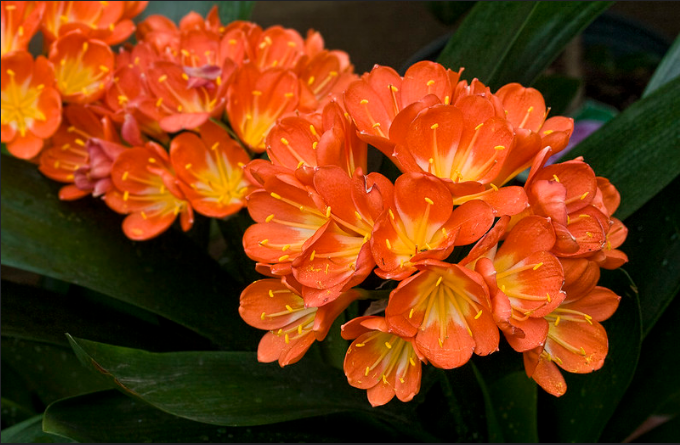
The greatest thing about clivias, besides their beautiful flowers, is the fact that they are so easy to grow. They can survive some neglect and they won’t mind if you forget about them once in a while, but they also need a little love and care.
They love the shade, so make sure they receive plenty of dappled shade and protection from the midday sun.
Clivias will benefit from a small amount of natural light such as early morning sun, as long as it’s not too intense. The foliage of Clivia plants is sensitive and can become scorched if the plant sits out in the sun, even if it’s just for one day.
If you live in a colder region, make sure you protect your clivias from frost. If you grow them in containers, it’s best to move them indoors.
The growing season for Clivia plants is from spring through fall. The optimal temperatures for this interval are between 21°C (70°F) or more during the day and no less than 10°C (50°F) at night. Once the growing period is over, the clivias will go through a dry resting phase that will be followed by intense blooming. When grown in favourable conditions, clivias produce flowers around February. Expert growers encourage blooming by pot-binding or root-binding the plants (allowing the roots to fill the container).
What Soil Suits Clivias Best?
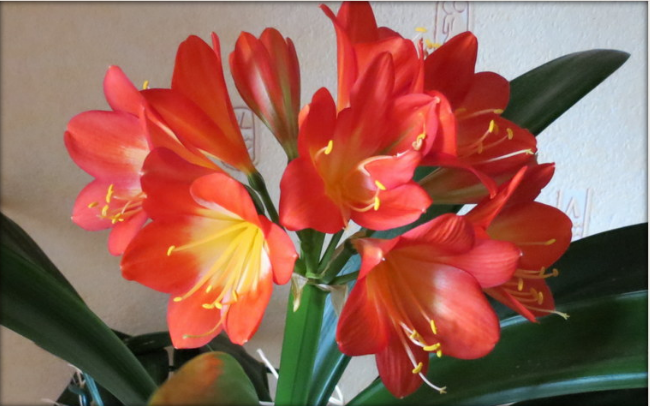
In their natural habitat, clivias are found growing on top of rotting logs and other types of organic materials. Therefore, they are not very picky when it comes to the soil as long as it is well-draining and loamy.
Any good potting medium will work, especially if it’s a gritty mix of leafmould, pine bark, and sand. Some growers opt for a soil mix that consists of 5 parts bark, 1 part peat, and 1 part perlite. Small particle mediums such as fine sand, peat, or anything smaller than a pea can lead to root rot.
Clivias have a fleshy root system that enjoys organic matter, so you can add more whenever you repot the plants. When repotting your Clivia plant, make sure you keep the neck of the bulb above the soil level.
How to Water Clivia Plants?

Clivias can withstand a little drought. They prefer to get more water during the growing season (spring-fall) and less during the cold winter months. As a general rule, clivias need slightly moist soil but you can also apply the ‘soak and dry’ technique, to avoid overwatering. Check the top two inches of soil and add more water only when it feels dry to the touch.
The dormancy phase lasts between 12 and 14 weeks and starts in late fall. At this point, you should move your plants indoors and withhold water and fertilizer.
It is also recommended to adjust the frequency and amount of watering based on the temperatures and the surrounding environment.
How Much Light Do Clivia Plants Need?
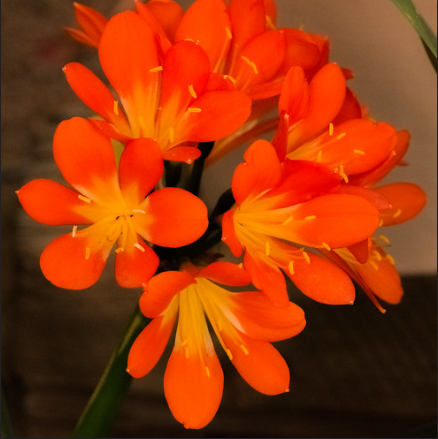
Like many flowering houseplants, Clivias thrive in bright indirect light. You can place your Clivia near a bright east or west-facing window. If the sun shines too brightly during the day, you can protect your plant with sheer curtains.
During the summer, Clivias can be grown outdoors, as long as they get plenty of shade. Although they can get used to brighter conditions over time, brutal sun exposure should always be avoided.
The best thing about Clivias is that they are low-light plants. This means that you don’t have to worry about them getting enough light. You can simply place them wherever you want, even in a dimly lit corner, and they’ll still grow. But, without a few hours of light per day, they will probably not flower.
What Temperatures and Humidity Levels Are Best for Clivias?

During the growing season (spring-summer), the optimal temperature for Clivia plants is around 15°C (60°F). Clivias cannot tolerate intense heat, so for optimal growth, the temperatures shouldn’t exceed 18°C (65°F).
Clivias can tolerate a very small amount of frost, as long as the average temperatures don’t drop below 4°C (40°F). When exposed to heavy frost, clivias will drop their leaves.
To encourage flowering, maintain the temperatures between 10°C and 15°C (50°F – 60°F) and withhold watering and fertilizing until a flower stem appears (or for at least two months).
Clivias don’t need a lot of humidity so misting them is not recommended.
Do Clivia Plants Need Fertilizer?
Yes, you can fertilize your clivias with liquid fertilizer or with a slow-release one during the growth season.
If you use a liquid fertilizer, apply it twice a month. A 6-6-6 nitrogen, phosphorus, and potassium slow-release fertilizer will feed the plants for at least three months.
Don’t use fertilizer during the cold winter months because that’s when the plant is resting. You can resume once your clivia produces its first flowers (usually in late winter or early spring).
How to Propagate Clivia Plants from Seeds?
There are two effective ways to propagate your beloved Clivias: through seeds and offsets.
If you choose the first method, you should know that only pollinated Clivias will produce seeds. In the wild, this process is carried out by pollinators such as insects and birds. But in a controlled environment, you’ll have to take care of the pollination process yourself. It’s not as difficult as it sounds. All you have to do is transfer the pollen from one flower to another by using a soft, thin paintbrush.
Do this for 5 consecutive days. If a green pod appears at the base of the flower, your efforts were not in vain. The pod will quickly develop into a grape-sized berry that will change its color to red, peach, or yellow as it matures. The color of the berries will usually indicate the color of the flowers so you’ll know whether or not you have a valuable specimen from the get-go.
So, the clivia seed pots can be harvested as soon as they change their colour. The next step is planting them. Press them halfway into the compost while leaving the darker part facing upwards. Don’t cover the container and keep it out of the sun.
You can also find clivia seeds on the market, but shop with caution, especially if they are expensive.
How to Propagate Clivia Plants from Offsets?
If propagating Clivia plants from seeds sounds a bit difficult, there’s an easier way to make more plants out of one. You can separate the offsets from the mature plant and plant them in a separate container. Expert growers advise us to divide the offsets during the growth period, preferably after the plant has flowered.
To propagate your Clivia through division, expose the offset by washing away the compost and use a sterilized sharp knife to cut it off. Move it to a new container filled with a well-draining medium and, water thoroughly, and use a fungicide to prevent pests and diseases.
Growing Clivias in Pots
Clivias make perfect houseplants because they thrive when planted in pots. It’s highly recommended to plant your clivias in containers that can be moved around, instead of planting them in the ground because can’t tolerate extreme heat, direct sun, and frost. Additionally, Clivias can live for decades and you might want to leave yours to future generations.
To encourage flowering, plant your Clivia in a deep container that’s at least 20cm (8 inches) in diameter and that has drainage holes. You can leave your Clivia in the same pot for several years until its root system fills outgrows it entirely. These plants thrive when they are pot bound, so they don’t need frequent repotting. To revitalize the soil, add a fresh layer every year.
The Six Different Species of Clivia
All six species of Clivia are evergreen and have a fleshy root system that enables them to withstand drought by storing plenty of water. Although people seemed to have forgotten about Clivia plants for a while, they have recently been “rediscovered” and are more popular than ever.
Because they can thrive in pretty much any environment, Clivias are perfectly adapted to modern life. They can be grown indoors and outdoors, preferably in containers. These spectacular plants will reward you with their colorful flowers if you offer them a deep, tight container, plenty of shade, some water now and then, and if you keep them out of the direct sun.
Clivia Miniata

‘Minata’ is the most wildly cultivated species of Clivia and the name refers to the unique aspect of its flamed-colored flowers (‘minata’ means “colored with red lead or cinnabar”). In its natural habitat, Clivia minata thrives in well-draining soil and shady places. So, you’ll find it on slopes, under tree covers, on rocky ledges, and even between sandstone boulders. The places of origin of the Clivia minata are Eastern Cape Province to Swaziland and KwaZulu-Natal.
Clivias are impressive plants that can grow up to 1 meter high. Their flowers grow in clumps, and their foliage is between 50mm wide (when grown in the wild) and up to 100mm wide (when cultivated). The elongated leaves of the Clivia minata can reach 1 meter in length.
The most exciting thing about Clivias is their blossom, which in the case of the Clivia minata is usually orange. But, in cultivation, it can also be yellow, peach, pink, cream, and even green. Some of these colors are pretty rare and people are willing to spend a fortune to get their hands on a unique specimen.
Clivia Caulescens
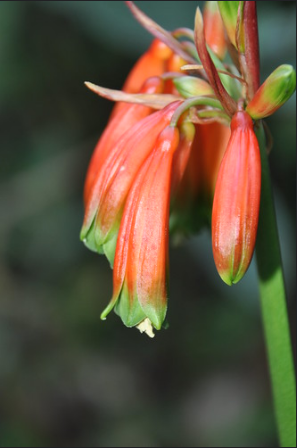
Although Clivia caulescens is a lesser-known cousin of the Clivia miniata, it is just as beautiful, if not even more. What makes Clivia caulescens unique is the shape of its flowers, which are quite different from the flowers of the minata.
The blossoms of the C. caulescens dangle gracefully downwards, are salmon-red and have contrasting green tips. Another great thing about this type of Clivia is that it can flower several times a year and its flower stalks can sometimes produce as many as 50 gorgeous blooms.
Clivia Gardenii
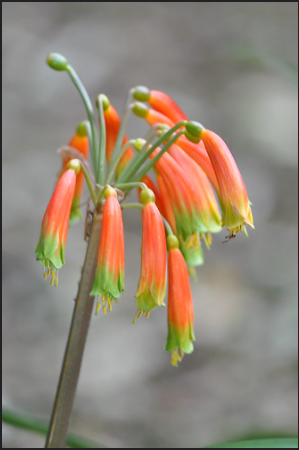
Clivia gardenia is somewhat similar to Clivia caulescens in terms of flowers and growth requirements, but its foliage is different. The leaves of the C. gardenii can reach 1m in length, they have pointed tips, and they have a pale section near the stalk. The flowers of the C. gardenia are usually red or orange, but you can also find rare cultivars that produce pink or yellow flowers.
Clivia Mirabilis
Finding a beautiful flower in an inhospitable environment was a miracle for the explorers, so this Clivia was named ‘mirabilis’. C. mirabilis was discovered recently and in 2001, it was confirmed as a different type of Clivia. You’ll rarely find it in cultivation because it’s very sensitive to over-watering and without perfect drainage, its roots will quickly rot. In the wild, C. mirabilis grows in the Northern Cape, in the Oorlogskloof Reserve where it thrives in evergreen forests and the cracks of sandstone rocks. The thick roots of the C. mirabilis prefer a rocky environment, and prefer dry environments, especially during the dormancy period.
This Clivia can grow up to 1.2 meters in height and its foliage has distinctive white variegation which fades as the plant matures. The blooms are tubular and similar to those of the C. gardenii and C. caulescence and are orange, red, or pink.
Clivia Nobilis
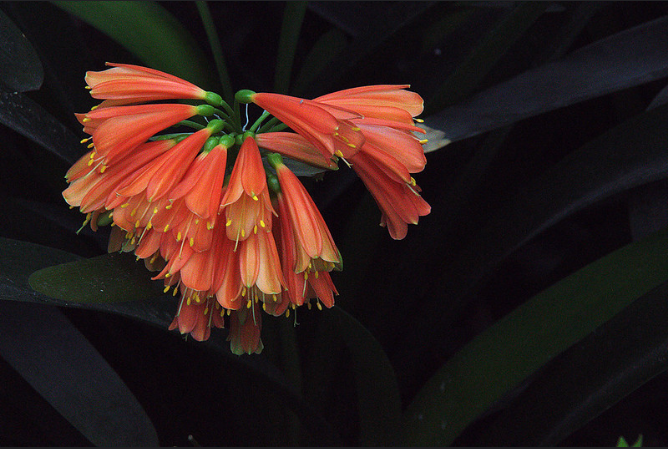
What makes Clivia nobilis special is the fact that it was the first species of Clivia discovered and it was named after Lady Charlotte Florentia Clive, the Duchess of Northumberland. In the wild, C. nobilis is only found in the coastal areas of the Eastern Cape. It thrives under the thick canopy of evergreen forests, in coastal dunes, on river banks, and rocky terrain.
The main particularities of the C. nobilis are its serrated leaves and its slow-developing seedlings. So, if you want to grow this species of clivia you need to have plenty of patients. The good news is that C. nobilis will reward your patience by producing up to 60 florets at a time. Furthermore, they are much more tolerant to being grown in containers and gardens than other clivias. They are less sensitive to drought and they aren’t often disturbed by fungal diseases.
Clivia Robusta

As the name implies, this clivia is considered a robust version of the C. gardenii. In the wild, it thrives near water, in swampy areas, and other shady corners of the forest. It can grow up to 2 meters in height and its majestic leaves can be to 1.2 meters long and almost 1 meter wide.
The pendulous flowers of the C. robusta can vary in color from orange-red with green tips to green-yellow, peach, or pink. As mentioned above, this species of clivia is very similar to C. gardenia, but what makes it special is its ability to adjust to almost any type of environment, from moist and fertile soil to well-draining mix.
Final Thoughts
Now you are a clivia expert and you can successfully grow this amazing plant at home. We hope that our guide convinced you to add a clivia to your collection, to care for it, and to pass it on to your children.
If you’ve never had a clivia plant, we recommend starting with an affordable and forgiving cultivar, such as C. robusta or a red C. minata.
Is there something else you’d like to know about these majestic plants?
Let us know in the comments.

